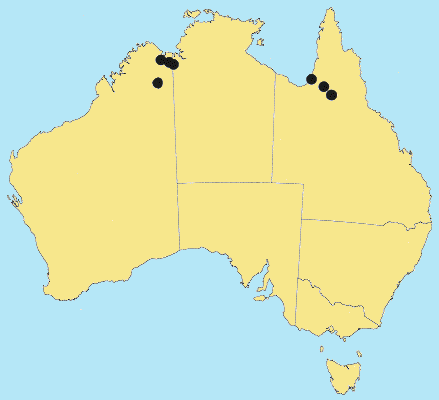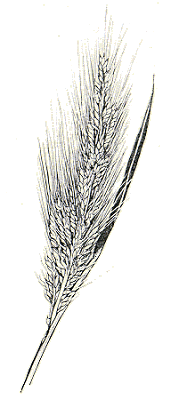Echinochloa kimberleyensis P.W. Michael & J.W. Vickery. Telopea 2: 25 (1980).
Classification. (GPWG 2001) : Subfamily Panicoideae. Paniceae.
Type of Basionym or Protologue Information: Australia: Western Australia: grown at Kimberley Research Station, dispatched Nov 1950, E. C. B. Langfield 211 (HT: CANB-24931; IT: CANB-24391a).
Key references (books and floras): [2002] D.Sharp & B.K.Simon, AusGrass, Grasses of Australia.
Habit. Annual. Rhizomes absent. Stolons absent. Culms erect, stature robust to moderate, 70–200 cm tall, 3–5 mm diam., compressible, 5–6 -noded. Mid-culm nodes glabrous. Leaf-sheaths glabrous on surface. Ligule a fringe of hairs, 0.25–1 mm long. Leaf-blades 15–42 cm long, 4–15 mm wide. Leaf-blade surface smooth, glabrous.
Inflorescence. Inflorescence compound, a panicle of racemes. Racemes 7–15, erect or ascending, 2–7 cm long. Central inflorescence axis 10–25 cm long.
Spikelets. Spikelets pedicelled. Fertile spikelets 2-flowered, the lower floret barren (rarely male), the upper fertile, comprising 1 basal sterile florets, comprising 1 fertile floret(s), without rachilla extension, elliptic, dorsally compressed, 5–7.5 mm long. Rhachilla internodes elongated between glumes.
Glumes. Glumes dissimilar, thinner than fertile lemma. Lower glume ovate, membranous, without keels, 3–5 -nerved. Lower glume apex muticous. Upper glume elliptic, 4.7–6.7 mm long, membranous, without keels, 5–7 -nerved. Upper glume surface scabrous. Upper glume apex awned. Florets. Basal sterile florets 1, barren, with palea or without significant palea. Lemma of lower sterile floret 100 % of length of spikelet, membranous, 5 -nerved, awned.
Fertile lemma 4.6–6.5 mm long, without keel, 5 -nerved. Lemma apex mucronate or awned. Anthers 3. Grain 2.75–3.5 mm long.
Continental Distribution: Australasia.
Australian Distribution: Western Australia, Queensland.
Western Australia: Gardner. Queensland: Cook, Burke.
Notes. Diagnostic characteristics of E. kimberleyensis include spikelet length, the appressed primary branches of the inflorescence, the absence of stamens in the lower floret, and the attenuate spikelet base.
In tropical and subtropical sub-humid woodlands. Echinochloa kimberleyensis, E. macrandra and E. elliptica are known from tropical regions of Australia and form a native complex of robust annual species. Flowers Feb.-July.




